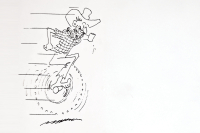Squirrel stories
It seems to me that the general reputation of squirrels has declined within my own lifetime. I don’t recall hearing negative remarks about squirrels when I was growing up; indeed, most folks that I encountered back then seemed to hold them in rather high esteem. That’s no longer the case. It’s my guess that this turnabout took place because of the explosion in bird watching and feeding that has taken place in the last 30 or so years. Because squirrels are so adroit and persistent at raiding bird feeders, they are now quite often referred to as “tree rats.”
But I like squirrels and will continue to defend their antics whenever possible. After all, they’re just doing what squirrels are programmed to do, which is to rather obsessively gather and store food in great quantities. Without gray squirrels we wouldn’t have the widespread oak forests that are one of the crowning glories of eastern North America. And you have to admit that watching a squirrel execute a well-planned raid on a bird feeder can be as interesting as watching a well-executed double play in baseball. It’s all about grace and balance and timing.
There are four species of tree squirrel that are resident in the Blue Ridge province: gray squirrels; fox squirrels; red squirrels; northern flying squirrels; and southern flying squirrels. My favorite is the red squirrel, which is often known locally as the “mountain boomer.” I have also heard them called “pine” squirrels, because unlike gray squirrels, which prefer oak forests and acorns, these little critters often frequent conifer stands to feed upon seeds. In the Blue Ridge, they are found primarily in hemlock and spruce-fir forests, but sometimes they’ll frequent mixed conifer-hardwood forests.
Whereas a gray squirrel will average about 18 inches in length and sometimes weigh a pound, a boomer will be about 12 inches and hardly exceed half a pound. Its reddish-dark back and light belly are separated in summer by a lateral black stripe. The tail hairs are yellow tipped.
There is a prominent white ring around each eye that gives the little animal a constantly alert appearance. It’s my supposition that these eye rings act as light collectors, allowing boomers to see better in dim light conditions than would otherwise be the instance. Some deep forest bird species — like the blue-headed vireo, for example — have similar markings for the same reason.
In addition to seeds, boomers will chow down on acorns, beechnuts, walnuts, and similar fare. Researchers who have investigated their nests often find parts of mushrooms that have been carefully cut and carried into a tree cavity. There they are wedged into a crevice to dry before being consumed. Based on this evidence, it appears that boomers readily devour “destroying angels” and other poisonous mushrooms that would kill a human.
Related Items
Boomers are so pugnacious and feisty that a “tree warrior” legend has evolved; indeed, they are so highly successful in their battles with gray squirrels that some hunters here in Western North Carolina where I reside have accused them of castrating their rivals; indeed, adult male gray squirrels lacking testes are cited as evidence. This myth perhaps arose from the fact that adult male gray squirrels sometimes retract their testes into the body wall where they are not seen except during the breeding season.
And boomers are so quick that legends regarding their speedy movements have also evolved. In 1986, Western North Carolina folklorist and newspaper columnist John Parris devoted a three-part series to boomers. His first installment in the series was titled “The ‘Boomer’ Is Our Speediest Varmint.” It opened with this paragraph:
There’s no animal as fast as the mountain boomer, the little red squirrel that haunts our high-altitude forests. ‘He’s so fast,’ said Lindsey Rogers, a mountain man who grew up at a time when the woods were full of boomers, ‘he can cut a buckeye off the limb of a tree and outrun it to the ground. He’ll be standing there and looking up by the time it hits the ground.
George Ellison wrote the biographical introductions for the reissues of two Appalachian classics: Horace Kephart’s Our Southern Highlanders and James Mooney’s History, Myths, and Sacred Formulas of the Cherokees. In June 2005, a selection of his Back Then columns was published by The History Press in Charleston as Mountain Passages: Natural and Cultural History of Western North Carolina and the Great Smoky Mountains. Readers can contact him at P.O. Box 1262, Bryson City, N.C., 28713, or at This email address is being protected from spambots. You need JavaScript enabled to view it..









